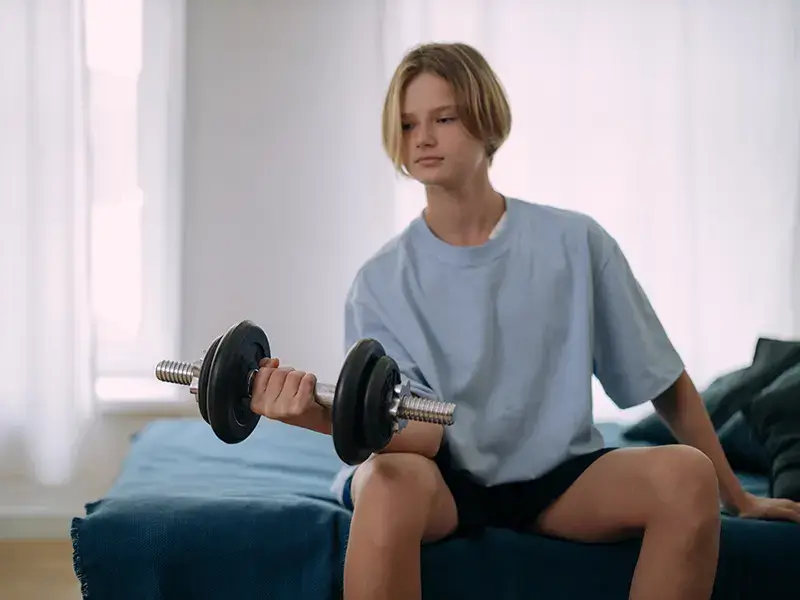
It is normal when kids want to perform a weight training program. It’s even recommended for weight loss by doctors especially if the young adult is on the verge of obesity. The sad thing about weight training for teenager who do lifting exercise and workout is that others start doing the routines when they’re already older or when their bodies turn to jiggle a lot because of too much fat. In physical exercises, the earlier the better is the key. Teenagers need to know how to take care of their health and body appearance as early as possible. Strength training for teenagers can do a lot of wonders in the child’s lifestyle.
Advantages of Weight Training for Teenagers
There are a lot of benefits and advantages on weight training for teenagers. Probably the most important of them are the benefits that clearly affect their health. Listed below are the health benefits of weight training exercises to teenagers:
- The muscle building training strengthen the teenager’s body particularly his or her muscles and bones. This will help reduce any forms of osteoporosis or any lower back pains in the future.
- Lifting weights can boost the metabolism of the teenager.
- Strength training activities are great to fix or to improve the coordination or balance problem of a teenager.
- The activity can definitely tone the muscles of the teenager. It will not just boost their energy; it will also boost their self confidence.
- Workouts and exercise routines can keep the teenager occupied so there’s just a small window of opportunity for bad elements like drugs and too much alcohol to worry about.
Tips and Tricks for Teenagers
The following are some tips and tricks for a teenager or a teenager’s parent to do and follow for a safer routine for the children.
- Consult the doctor. If you’re a teenager who wishes to start weight lifting programs, you should ask your parents or guardians to accompany you to the doctor. Consultation is important to avoid any health risks in the future. Of course if you have a heart ailment, the doctors can advice you on what types of routines can both benefit your heart and will keep it away from heart strains.
- Research about bodybuilding. Teenagers are eager and impulsive by nature. And though, these qualities are adorable, it can also create harm. If the teenager decided to enroll in the gym for fitness training then you need to do a research about it. You have to know what types of routines your body can handle. Make sure to know your strengths and weaknesses so you’ll have an idea what to improve and what to enhance. You also need to research the variety of nutrition that you need to take.
- As much as possible, say no to supplements. Try to exercise without any help from pills and drugs to avoid health complications in the future.
Note from Brigadoon Fitness
Weightlifting and strength training can be highly beneficial for teenagers who participate in sports. By increasing strength, preventing injury, improving power, enhancing endurance, improving mental resilience, and building confidence.
Here are a few important considerations for teenagers who want to lift weights:
- Proper technique and form: To minimize the risk of injury it’s crucial for teenagers to learn and perform exercises with proper technique and form. Working with a qualified strength and conditioning coach or a knowledgeable fitness professional can help ensure they learn the correct techniques.
- Start with lighter weights and progress gradually: Teenagers should always begin with lighter weights and gradually increase the intensity as they become more comfortable and develop proper strength and form. This approach allows their bodies to adapt and reduces the risk of overloading muscles and joints.
- Focus on proper warm-up and cool-down: Always encourage teenagers to warm up before each workout to increase blood flow to the muscles and prepare the body for exercise. Cooling down afterward with stretching can help improve flexibility and reduce muscle soreness.
- Balance and variety: It’s important to include a variety of exercises that target different muscle groups to promote a balanced muscular development as well as prevent injuries. This includes exercises for the major muscle groups like squats, deadlifts, lunges, chest presses, shoulder presses, rows, and core exercises.
- Rest and recovery: Rest days are crucial for muscle recovery and growth. Encourage teenagers to have regular rest days between strength training sessions and to listen to their bodies. Overtraining can lead to increased risk of injury and hinder progress.
- Safety precautions: Teenagers should always use appropriate safety equipment, such as weightlifting shoes, belts, and spotter assistance when needed. Additionally, they should avoid lifting weights that are too heavy for their current strength level.


